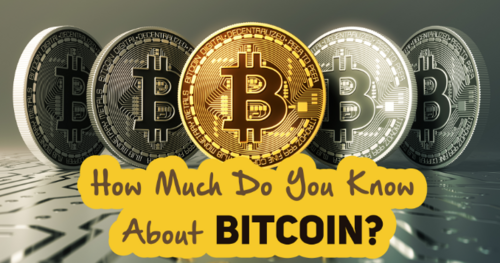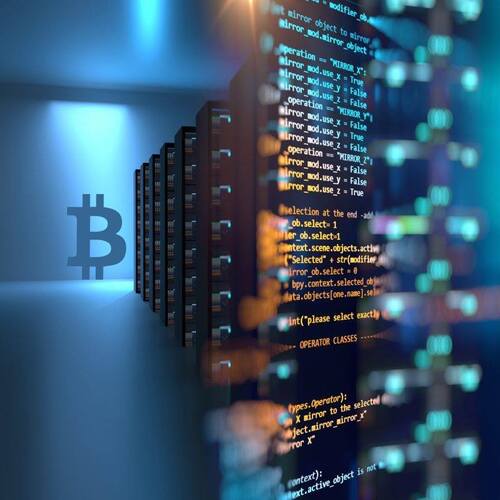

Bitcoin is more than a cryptocurrency used for payments or as an investment. There is an entire ecosystem at work behind a cryptocurrency. In fact, many such ecosystems are at work on the internet today, but because Bitcoin was the first, it's useful to understand how it functions.
So how does Bitcoin work? Bitcoin is a decentralized digital currency that operates without the need of financial system or government authorities. It utilizes peer-to-peer transfers on a digital network that records all cryptocurrency transactions. This network is powered by the blockchain, an open source code that pairs (or chains) blocks of transaction histories to prevent manipulation.
Because these transfers are confirmed directly between users and are located on a shared public ledger, Bitcoin eliminates the need for central facilitators, like governments and banks, to verify currency transactions.
Learn what's going on behind the scenes in the Bitcoin network to help you further your understanding of this digital phenomenon and how it influences the world's finances.
Bitcoin is a digital currency, often referred to as a cryptocurrency, that was created in 2009 by an unknown person or group of people using the pseudonym Satoshi Nakamoto. It is based on a decentralized, peer-to-peer network that allows for the transfer of value without the need for a central authority, such as a government or financial institution, to facilitate transactions.
Bitcoin transactions are recorded on a public ledger called the blockchain, which is maintained by a network of computers known as nodes. These transactions are verified by network participants, known as miners, who use powerful computers to solve complex mathematical problems. Once a transaction is verified, it is added to the blockchain, and the miner is rewarded with a small amount of bitcoin for their efforts, a process known as mining.
Bitcoin has several key characteristics, including decentralization, transparency, and security. It is often used as a form of digital currency, allowing users to send and receive payments across borders quickly and with low fees. Bitcoin can also be used as an investment, with some people buying and holding it as a store of value or a hedge against inflation. However, it is important to note that the value of Bitcoin can be highly volatile and there are risks associated with investing in it.
Bitcoin has gained significant attention and popularity since its inception, with a growing number of merchants and businesses accepting it as a form of payment. However, it is not widely accepted as a mainstream form of payment yet, and its regulatory status varies across different countries and jurisdictions. It is important to understand the legal and regulatory framework surrounding Bitcoin in your specific location before using or investing in it.

Bitcoin is a decentralized digital currency that allows people to send and receive payments over the Internet without the need for a central authority or intermediary. It was created in 2009 by an unknown person or group using the pseudonym Satoshi Nakamoto and is based on a peer-to-peer network known as blockchain.
The blockchain is a public ledger that records all Bitcoin transactions. It is maintained by a decentralized network of computers, known as nodes, that work together to validate and verify transactions. Each transaction is bundled into a block, and new blocks are added to the blockchain in a linear and chronological order, forming a chain of blocks. This creates a transparent and immutable record of all transactions that have ever occurred on the Bitcoin network.
Bitcoin transactions are secured using cryptography. Each transaction is digitally signed with a private key, which is a unique cryptographic key that belongs to the owner of the Bitcoin. The private key is kept secret and is used to prove ownership of the Bitcoin when making transactions. The recipient of the Bitcoin has a public key, which is a cryptographic key that can be shared with others, and it is used to verify the digital signature and ensure that the transaction is legitimate.
Bitcoin mining is the process by which new Bitcoins are created and transactions are verified on the blockchain. Miners use specialized computer hardware to solve complex mathematical problems that validate transactions and add new blocks to the blockchain. In return for their computational efforts, miners are rewarded with newly created Bitcoins and transaction fees paid by users who want their transactions to be prioritized.
Bitcoin operates on a deflationary model, with a limited supply cap of 21 million Bitcoins. This means that the total number of Bitcoins that can ever exist is fixed, which makes it different from traditional currencies that can be printed or created by central banks. The limited supply of Bitcoin, combined with its decentralized nature and increasing adoption, has led to its value being determined by supply and demand dynamics in the market, resulting in price volatility.
In summary, Bitcoin is a digital currency that uses a decentralized network and blockchain technology to enable peer-to-peer transactions without the need for a central authority. Transactions are secured using cryptography, and new Bitcoins are created through a process called mining. It’s important to understand the technical aspects and risks associated with Bitcoin before using it or investing in it.
.jpg)
The purpose of Bitcoin is to serve as a decentralized digital currency that enables peer-to-peer transactions without the need for a central authority, such as a government or financial institution, to facilitate or verify transactions. Bitcoin was created as an alternative to traditional financial systems and currencies, with the following key objectives:
It’s important to note that Bitcoin’s purpose and potential uses are constantly evolving, and it is still a relatively new and rapidly developing technology with both advantages and risks. As with any financial tool, it’s essential to understand the risks and limitations of Bitcoin before using it for any purpose.

Here are some general steps on how to buy Bitcoin:
It’s important to note that the process of buying Bitcoin may vary slightly depending on the exchange and location, and it’s essential to follow the specific instructions provided by the exchange and exercise caution to protect your personal and financial information. It’s also advisable to research and understand the risks associated with buying and using Bitcoin before proceeding.

The Bitcoin blockchain is a database of transactions secured by encryption and validated by peers. Here's how it works. The blockchain is not stored in one place; it is distributed across multiple computers and systems within the network. These systems are called nodes. Every node has a copy of the blockchain, and every copy is updated whenever there is a validated change to the blockchain.
The blockchain consists of blocks, which store data about transactions, previous blocks, addresses, and the code that executes the transactions and runs the blockchain. So, to understand the blockchain, it's important first to understand blocks.
When a block on the blockchain is opened, the blockchain creates the block hash, a 256-bit number that encodes the following information:
Queued transactions are entered into the block, the block is closed, and the blockchain creates the hash. Each block contains information from the previous blocks, so the blockchain cannot be altered because each block is "chained" to the one before it. Blocks are validated and opened by a process called mining.
Mining is the process of validating transactions and creating a new block on the blockchain. Mining is conducted by software applications that run on computers or machines designed specifically for mining called Application Specific Integrated Circuits.
The hash is the focus of the mining programs and machines. They are working to generate a number that matches the block hash. The programs randomly generate a hash and try to match the block hash, using the nonce as the variable number, increasing it every time a guess is made. The number of hashes a miner can produce per second is its hash rate.
Mining programs across the network generate hashes. The miners compete to see which one will solve the hash first—the one that does receives the bitcoin reward, a new block is created, and the process repeats for the next group of transactions.
Bitcoin's protocol will require a longer string of zeroes depending on the number of miners, adjusting the difficulty to hit a rate of one new block every 10 minutes. The difficulty—or the average number of tries it takes to verify the hash—has been increasing since Bitcoin was introduced, reaching tens of trillions of average attempts to solve the hash.1 As this suggests, it has become significantly more difficult to mine Bitcoin since the cryptocurrency launched.
Mining is intensive, requiring big, expensive rigs and a lot of electricity to power them. And it's competitive. There's no telling what nonce will work, so the goal is to plow through them as quickly as possible with as many machines working on the hash as possible to get the reward. This is why mining farms and mining pools were created.
Halving is an important concept in Bitcoin mining. At first, the mining reward was 50 BTC for solving the hash. About every four years, or 210,000 blocks, the reward is cut in half. So rewards were cut to 25 in 2012, 12.5 in 2016, and 6.25 in 2020. The next halving is expected to occur in 2024 when the reward will reduce to 3.125, followed by a reduction to 1.5625 around 2028.
The last bitcoin is expected to be mined somewhere around 2140. All 21 million bitcoins will have been mined at that time, and miners will depend solely on fees to maintain the network.

A common question from those new to Bitcoin is, "I've purchased a bitcoin, now where is it?" The easiest way to understand this is to think about the Bitcoin blockchain as a community bank that stores everyone's funds. You view your balance using a wallet, which is like your bank's mobile application.
If you're like many people today, you don't use cash very often and never see the money in your checking account. Instead, you use credit and debit cards, which act as tools to access and use your money. You access your bitcoin using a wallet and keys.
A bitcoin at its core is data with ownership assigned. Data ownership is transferred when transactions are made, much like using your debit card to transfer money to an online retailer. You use your wallet, the mobile application, to send or receive bitcoin.
When bitcoin is assigned to an owner via a transaction on the blockchain, that owner receives a number, their private key. Your wallet has a public address—called your public key—that is used when someone sends you a bitcoin, similar to the way they enter your email address in an email.
You can think of the public and private keys like a username (public key) and password (private key) used to access your funds.
A wallet is a software application used to view your balance and send or receive bitcoin. The wallet interfaces with the blockchain network and locates your bitcoin for you. The blockchain is a ledger with portions of bitcoin stored on it. Because bitcoin is data inputs and outputs, they are scattered all over the blockchain in pieces because they have been used in previous transactions. Your wallet application finds them all, totals the amount, and displays it.
There are two types of wallets, custodial and noncustodial. A custodial wallet is one where a trusted entity, like an exchange, holds your keys for you. For example, when you sign up for a Coinbase exchange account, you can elect to have them store your keys for you as custodians.
Noncustodial wallets are wallets where the user takes responsibility for securing the keys, such as in your wallet application on your mobile phone. Storing keys in an application connected to the internet is referred to as hot storage. However, hot storage is the vulnerability most often exploited.
You should always use a reputable wallet provider, like from a registered cryptocurrency exchange. Read reviews and research wallets to ensure you're choosing one that is reliable.
To remedy this, the cryptocurrency community has developed methods for storing your keys offline. Most commonly, you'll hear about hot storage, cold storage, and deep cold storage. Hot storage is any wallet that stores your keys and has an active connection to the internet; this is the most vulnerable method. An example of a hot wallet is the wallet application on your mobile device.
Cold storage is any method that is not connected to the internet. This could be a removable USB drive or a piece of paper with your keys written on it (this is called a paper wallet). Deep cold storage is any cold storage method that is secured somewhere that requires additional steps to access the keys beyond removing the USB drive from your desk drawer and plugging it in. Examples might be a personal safe or storage deposit box—anything that takes extra effort to retrieve your keys.
A bitcoin transaction happens when you send or receive a bitcoin. To send a coin, you enter the receiver's address in your wallet application, enter your private key, and agree to the transaction fee. Then, press whichever button corresponds to "send." The receiver must wait for the transaction to be verified by the mining network, which can take up to 30 minutes because transactions wait in a mining queue called the mempool.2
The mempool is where transactions waiting to be verified go. The network, on average, confirms a block of transactions about every ten minutes, but not all new transactions go into the new block that is created. This is because blocks only hold a certain amount of information, and each transaction comes with a mining fee.
Transactions must meet the minimum transaction fee threshold to be processed, and the transactions with the highest fees are processed first. This is why you may hear about the problem of rising fees. Bitcoin is so popular that demand for transactions has increased, allowing (or requiring) miners to charge higher fees.
Transaction fees were established to create an incentive for people to become network nodes and miners. Bitcoin mining is also expensive, so fees help to offset the cost of equipment and electricity used.
Once the fee is met, the transaction is transferred to a block, where it is processed. Once transaction information within the block is validated by miners, the block is closed, and all receivers collect their bitcoin. Both wallets display their appropriate balances, and the next transactions are processed.
There are many parts that make up the Bitcoin blockchain and network, but it is not necessary to understand it all to use this new currency technology. You only need to know that you use a wallet to send, receive, and store your bitcoin keys; you also should use a cold storage method for security because non-custodial wallets can be hacked.
Custodial wallets can also be hacked, but many who offer this service take measures to reduce the chances that hackers can get into the storage systems. Most are turning to enterprise-level cold storage techniques businesses use to store essential data for extended timeframes.
For good reason, many people are concerned about Bitcoin's level of security, especially since it involves exchanging money for encrypted data ownership. However, it's important to note that the Bitcoin blockchain has never been hacked because of the community consensus mechanisms used.
Wallets are the weak spot, so if you're looking to get involved in Bitcoin, it's essential to understand how to utilize cold storage methods and keep your keys out of your hot wallet.
Bitcoin wasn't designed as a means for making money but rather as a payment method accessible by everyone. However, some people use it as an investment. This is very risky and should only be done after talking to a professional financial advisor about your financial circumstances.
You can use some exchanges to convert your bitcoin to cash. There are also some ATMs—called Bitcoin Kiosks—that will allow you to withdraw cash in exchange for bitcoin.
Bitcoin's price is very volatile, which means it rises and falls very often, sometimes in large dollar increments. You can generate significant returns investing in Bitcoin, but you can also quickly lose substantial money. It's best to speak to a professional investment or financial advisor about your financial circumstances before investing in Bitcoin.
Investing in cryptocurrencies and other Initial Coin Offerings (“ICOs”) is highly risky and speculative, and this article is not a recommendation by the writer to invest in cryptocurrencies or other ICOs. Since each individual's situation is unique, a qualified professional should always be consulted before making any financial decisions. I make no representations or warranties as to the accuracy or timeliness of the information contained herein.

Andries van Tonder is a Digital Entrepreneur & Investor with over 40 Years of experience in Business and Marketing.
Business is my passion and I have established myself in multiple industries with a focus on sustainable growth.
You will generally find me online on Facebook, Twitter, WebTalk, Instagram & Markethive
